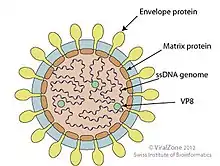Haloarcula hispanica pleomorphic virus 1
Haloarcula hispanica pleomorphic virus 1 is a double stranded DNA virus that infects the halophilic archaeon Haloarcula hispanica.[1] It has a number of unique features unlike any previously described virus.[2][3]
| Haloarcula hispanica pleomorphic virus 1 | |
|---|---|
 | |
| Alphapleolipovirus virion | |
| Virus classification | |
| Group: | Group I (dsDNA) |
| Family: | |
| Genus: | Alphapleolipovirus |
Virology
The virons are enveloped and pleomorphic is shape. The envelope contains a variety of lipids including cardiolipins, phosphatidylglycerols, phosphatidylglycerophosphate methyl esters and phosphatidylglycerosulfates. There are two major proteins in the envelope — VP3 (12 kiloDaltons in weight) and VP4 (60 kiloDaltons in weight).[1]
The virons exit the host without lysis suggesting a budding mechanism.[1]
Genome
The genome is a single molecule of double stranded DNA, circular, 8082 base pairs in length with a G+C content of 55.8%. It has eight open reading frames (ORFs). VP3 and VP4 are encoded by ORF3 and ORF4 respectively.
ORF1 is probably a replication initiation protein. ORF3 encodes an integral membrane protein with a 50 amino acid signal sequence and two transmembrane regions. Before the C-terminal transmembrane domain is a coiled-coil region. ORF7 contains a NTPase domain but its function is not clear.
Taxonomy
Examination of the proteins and genome organisation of this virus suggests that it related to the single stranded DNA virus Halorubrum pleomorphic virus 1, the plasmid pHK2 and a region within the archeon Haloferax volcanii. It seems likely that the plasmid pHK2 may be a virus that can form circular plasmids and that the region within Haloferax volcanii is a prophage.
The similarity between these double stranded DNA elements and the single stranded virus Halorubrum pleomorphic virus 1 is currently unique. If this relationship can be confirmed for other viruses it suggests that the currently used Baltimore system of classification may be in need of revision.
References
- Roine E, Kukkaro P, Paulin L, Laurinavicius S, Domanska A, Somerharju P, Bamford DH (2010) New, closely related haloarchaeal viral elements with different nucleic acid types. J Virol 84(7):3682–89
- Pietilä MK, Atanasova NS, Manole V, Liljeroos L, Butcher SJ, Oksanen HM, Bamford DH (2012). "Virion Architecture Unifies Globally Distributed Pleolipoviruses Infecting Halophilic Archaea". Journal of Virology. 86 (9): 5067–79. doi:10.1128/JVI.06915-11. PMC 3347350. PMID 22357279.
- Pietilä MK, Laurinavicius S, Sund J, Roine E, Bamford DH (2010). "The single-stranded DNA genome of novel archaeal virus Halorubrum pleomorphic virus 1 is enclosed in the envelope decorated with glycoprotein spikes". J Virol. 84 (2): 788–798. doi:10.1128/JVI.01347-09. PMC 2798366. PMID 19864380.